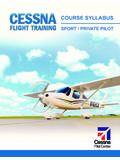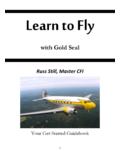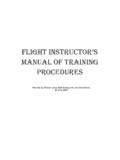Transcription of ROYAL CANADIAN AIR CADETS PROFICIENCY LEVEL FOUR ...
1 A-CR-CCP-804/PF-001. ROYAL CANADIAN AIR CADETS . PROFICIENCY LEVEL four . instructional guide . SECTION 1. EO EXPLAIN WINDS. Total Time: 30 min PREPARATION. PRE-LESSON INSTRUCTIONS. Resources needed for the delivery of this lesson are listed in the lesson specification located in A-CR-CCP-804/. PG-001, PROFICIENCY LEVEL four Qualification Standard and Plan, Chapter 4. Specific uses for said resources are identified throughout the instructional guide within the TP for which they are required. Review the lesson content and become familiar with the material prior to delivering the lesson. Prepare the slides or handouts located at Attachment A. PRE-LESSON ASSIGNMENT. Nil. APPROACH. An interactive lecture was chosen for this lesson to orient the CADETS to winds and generate interest in the subject. INTRODUCTION. REVIEW. Nil. OBJECTIVES. By the end of this lesson the cadet shall have explained winds. IMPORTANCE. It is important for the CADETS to explain winds as this information is used by pilots to be aware of the direction and speed of wind during all parts of the flight.
2 Being able to explain winds provides knowledge for potential instructional duties and is part of the fundamentals that CADETS pursing future aviation training will require. A-CR-CCP-804/PF-001. Teaching Point 1 Explain surface winds. Time: 15 min Method: Interactive Lecture SURFACE WINDS. Wind is a major factor in flight planning and flight characteristics. Pilots must constantly be aware of the direction and speed of wind during the flight, especially when close to the ground during takeoff and landing. Surface friction plays an important role in the speed and direction of surface winds. The friction between the air and the ground slows the air down causing a lower wind speed than would be expected from the pressure gradient. The friction also changes the direction causing the wind to blow across the isobars toward the centre of a low pressure area and away from the centre of a high pressure area. The effect of surface friction usually does not extend more than a couple of thousand feet into the air.
3 At 3 000 feet above the ground, the wind blows parallel to the isobars with a speed proportional to the pressure gradient. Hills and valleys substantially distort the airflow associated with the prevailing pressure system and the pressure gradient. Katabatic and anabatic winds and mountain waves are examples of wind phenomena in mountainous areas. Katabatic and Anabatic Winds Show slides of Figures A-1 and A-2. At night, the sides of hills cool by radiation. The air in contact with them becomes cooler and denser, and blows down the slope into the valley. A katabatic wind is the term for down slope winds flowing from high elevations down the slopes to valleys below. If the slopes are covered with ice and snow, the katabatic wind can also carry the cold dense air into the warmer valleys during the day. A-CR-CCP-804/PF-001. Figure 1 Katabatic Wind Note. From "Wind", by BBC, 2008. Copyright 2000 by BBC Weather Centre. Retrieved October 14, 2008, from Anabatic wind occurs during the day when the slopes of hills, not covered by snow, are warmed.
4 The air in contact with them becomes warmer and less dense, therefore flowing up the slope. Figure 2 Anabatic Wind Note. From "Wind", by BBC, 2008. Copyright 2000 by BBC Weather Centre. Retrieved October 14, 2008, from A-CR-CCP-804/PF-001. Mountain Waves Show slide of Figure A-3. Air flowing across a mountain range usually rises smoothly up the slope of the range. Once over the top, it pours down the other side with considerable force, bouncing up and down, creating eddies and turbulence. It also creates powerful vertical waves that may extend for great distances downwind of the mountain range. This phenomenon is known as a mountain wave. The most severe mountain wave conditions are created in strong airflows that are blowing at right angles to the mountain range in very unstable air. If the air mass has high moisture content, clouds of a very distinctive appearance will develop, thereby serving as a warning to pilots. Orographic lift causes a cap cloud to form along the top of the ridge.
5 Lenticular (lens- shaped) clouds form in the wave crests aloft and lie in bands that may extend well above 40 000 feet. Rotor clouds resemble a long line of stratocumulus clouds and form in the rolling eddies downstream. Figure 3 Mountain Wave Note. From "Integrated Publishing", 2003. Aerographer / Meteorology, Copyright 2003 by Integrated Publishing. Retrieved October 14, 2008, from Mountain waves may cause many dangers to aircraft, such as: common downdrafts of 2 000 feet per minute along the downward slope;. extremely severe turbulence in the air layer between the ground and the tops of the rotor clouds;. severe wind shear due to wind speed variation between the crests and troughs of the waves;. A-CR-CCP-804/PF-001. severe icing due to large supercooled droplets sustained in the strong vertical currents; and an altimeter error of more than 3 000 feet on the high side due to the increase in wind speed and accompanying decrease in pressure.
6 Gusts A gust is a rapid and irregular change of wind speed and may be associated with a rapid change in wind direction. Gusts are caused by mechanical turbulence that results from friction between the air and the ground and by the unequal heating of the earth's surface, particularly during hot summer afternoons. Wind gusts are a hazard to gliders due to their light weight and relatively slow stalling speed. Therefore, the Air cadet Gliding Program has a maximum permissible gust differential of 10 knots (12 mph). Any gust differential beyond this will require an immediate shutdown of gliding operations. Squalls A squall is a sudden increase in the strength of the wind of longer duration than a gust and like a gust, may be accompanied by a rapid change of wind direction. Squalls may be caused by the passage of a fast moving cold front or thunderstorm. CONFIRMATION OF TEACHING POINT 1. QUESTIONS: Q1. Explain anabatic wind. Q2.
7 What types of clouds are caused by mountain waves? Q3. What causes gusts? ANTICIPATED ANSWERS: A1. Anabatic wind occurs during the day when the slopes of hills not covered by snow are warmed. The air in contact with them becomes warmer and less dense, therefore flowing up the slope. A2. Cap clouds, lenticular clouds, and rotor clouds. A3. Gusts are caused by mechanical turbulence that results from friction between the air and the ground and by the unequal heating of the earth's surface. Teaching Point 2 Describe jet streams. Time: 10 min Method: Interactive Lecture JET STREAMS. Show slides of Figures A-4 and A-5. A-CR-CCP-804/PF-001. Jet streams are narrow bands of exceedingly high speed winds that exist in the higher levels of the atmosphere at altitudes ranging from 20 000 to 40 000 feet or more. They flow from west to east and are usually 300 nautical miles wide and 3 000 to 7 000 feet thick. Winds in the central core of a jet stream are generally between 100.
8 And 150 knots, although they may reach speeds as great as 250 knots. The northern hemisphere has two such streams: the mid-latitude (polar) jet, which is the one usually affecting weather in North America, Europe and Asia, and the subtropical jet. Figure 4 The Jet Stream Note. From "Remote Sensing Tutorial", by N. Short, 2005, Federation of American Scientists. Retrieved February 26, 2009, from When the mid-latitude jet is farther north, in Canada, the weather to its south tends to be mild or at least less cold. When the stream swings south well within the United States ( ), especially in winter, very cold, often harsh weather prevails at the surface on the northern side. A-CR-CCP-804/PF-001. Figure 5 Seasonal Mid-Latitude Jet Stream Note. From "Remote Sensing Tutorial", by N. Short, 2005, Federation of American Scientists. Retrieved February 26, 2009, from Knowing the location of a jet stream is important when planning long range flights at high altitudes.
9 For example, on an eastbound flight a pilot would want to take advantage of the excellent tail winds a jet stream would provide. On a westbound flight they would want to avoid the winds. Clear Air Turbulence (CAT). CAT is a bumpy, turbulent condition that occurs in a cloudless sky. It occurs at high altitudes, usually above 15 000 feet and is more severe near 30 000 feet. The most probable place to expect CAT is just above the central core of a jet stream. CAT is almost impossible to forecast and can be severe enough to be a hazard to modern high-performance airplanes. Therefore, knowledge of areas in which CAT is most likely to occur is important for pilots to help minimize encounters with it. CONFIRMATION OF TEACHING POINT 2. QUESTIONS: Q1. What are jet streams? Q2. In what direction do jet streams flow? Q3. Where is clear air turbulence most likely to occur? A-CR-CCP-804/PF-001. ANTICIPATED ANSWERS: A1. Jet streams are narrow bands of exceedingly high speed winds that exist in the higher levels of the atmosphere at altitudes ranging from 20 000 to 40 000 feet or more.
10 A2. Jet streams flow from west to east. A3. Clear air turbulence is most likely to occur just above the central core of a jet stream. END OF LESSON CONFIRMATION. QUESTIONS: Q1. What must pilots be aware of when close to the ground during takeoff and landing? Q2. List examples of wind phenomena in mountainous areas. Q3. What is the range of wind speeds in the central core of the jet stream? ANTICIPATED ANSWERS: A1. The direction and speed of wind. A2. Examples include: katabatic winds, anabatic winds, and mountain waves. A3. 100 to 150 knots but may reach speeds as great as 250 knots. CONCLUSION. HOMEWORK / READING / PRACTICE. Nil. METHOD OF EVALUATION. This EO is assessed IAW A-CR-CCP-804/PG-001, PROFICIENCY LEVEL four Qualification Standard and Plan, Chapter 3, Annex B, Aviation Subjects Combined Assessment PC. CLOSING STATEMENT. Wind is a major factor in flight planning and flight characteristics. Pilots must constantly be aware of the direction and speed of wind during all parts of the flight.







